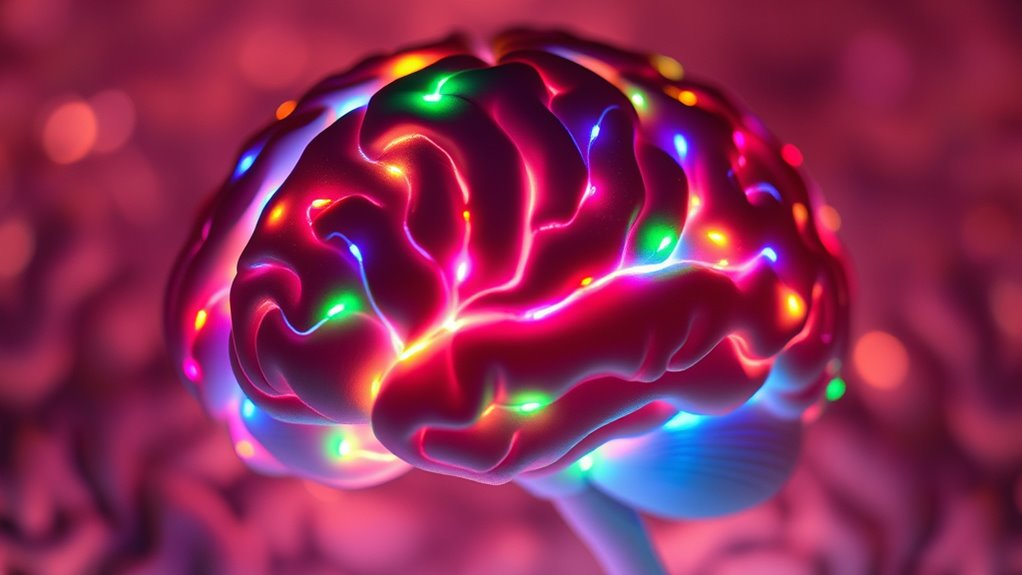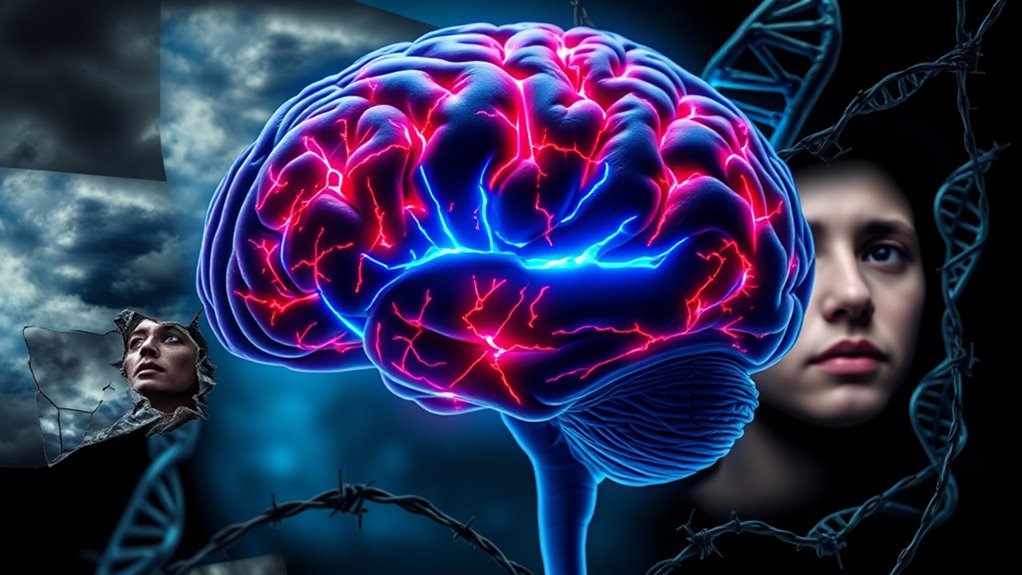Borderline personality disorder (BPD) is caused by a mix of genetics, early trauma, and brain chemistry. Your family’s history can increase your risk, especially if there’s a pattern of emotional issues. Childhood experiences like abuse or neglect often impact brain development, affecting emotional regulation. Changes in brain structure and imbalances in neurochemicals also play a role. If you want to understand how these factors interact, keep exploring.
Key Takeaways
- Genetics play a significant role, with heritability estimates between 40-60%, and twin studies showing high concordance rates.
- Childhood trauma, such as abuse or neglect, disrupts brain development and stress regulation, increasing BPD risk.
- Brain structure differences, including smaller frontal lobes and hippocampus and hyperactive amygdala, impair emotional regulation.
- Neurochemical imbalances, especially serotonin dysregulation, influence mood stability and impulsivity in BPD.
- Environmental factors like invalidating relationships and social adversity contribute to emotional instability and symptom severity.
The Role of Family and Hereditary Factors

Family and hereditary factors play a significant role in the development of Borderline Personality Disorder (BPD). You’re more likely to develop BPD if a parent or sibling has it, which suggests a strong genetic link. Studies show heritability estimates between 40% and 60%, meaning genetics account for a substantial part of the risk. Twin research indicates that about 67% of identical twins will both have BPD if one does, highlighting the genetic connection. Familial patterns also suggest that BPD runs in families, influenced by genetic transmission. Additionally, epigenetic changes, like DNA methylation, modify gene expression and contribute to susceptibility. While no single gene has been identified, the evidence points to a complex genetic and hereditary foundation influencing your risk. Genetic factors are considered a significant risk factor in understanding why some individuals develop BPD. Furthermore, research into family history can help identify individuals at higher risk, enabling earlier intervention and support. Emerging studies also highlight the role of epigenetic mechanisms in how environmental factors may interact with genetics to impact BPD development. These mechanisms can be influenced by trauma or stress, further complicating the genetic landscape.
Impact of Childhood Trauma and Early Experiences

Childhood trauma profoundly influences the development of Borderline Personality Disorder by disrupting key biological and psychological processes. When you experience sexual abuse, physical abuse, neglect, or emotional abandonment, it can alter how your brain and body respond to stress. Trauma affects the hypothalamic-pituitary-adrenal (HPA) axis, leading to chronic stress dysregulation, and changes neurotransmitter systems that govern mood and impulse control. Structural brain alterations, like reduced gray matter and connectivity issues, often persist into adulthood. These biological shifts contribute to emotional instability and impulsivity characteristic of BPD. Additionally, traumatic experiences can lead to a fragile sense of self, intense fear of abandonment, and maladaptive coping behaviors like self-harm. The cumulative effect of early trauma shapes core features of BPD, fueling ongoing emotional and relational struggles. Trauma-induced brain changes can also impair cognitive functions such as decision-making and emotional regulation, further exacerbating BPD symptoms.
Environmental and Social Influences on Development

Environmental and social factors substantially shape the development of Borderline Personality Disorder beyond early traumatic experiences. If you grow up in an invalidating family environment, where your emotions are dismissed or criticized, you might struggle with emotional regulation. Inconsistent caregiving or emotional neglect can impair your ability to manage feelings and form stable relationships. Early separation from caregivers or loss during critical developmental periods increases your fear of abandonment and hampers attachment. Experiencing physical, emotional, or sexual abuse, or social rejection, can heighten impulsivity and emotional instability. Additionally, socioeconomic adversity, community violence, or limited access to mental health resources can add stress and hinder emotional growth. These environmental influences, combined with personal vulnerabilities, contribute profoundly to BPD development. Environmental stressors can further exacerbate emotional dysregulation and impulsivity, intensifying the risk of developing BPD. Moreover, attachment disruptions during childhood may interfere with the development of secure emotional bonds, further increasing vulnerability. External factors like social rejection and community violence can also influence emotional resilience and coping strategies, impacting outcomes later in life. The presence of nutritional deficiencies may also play a role in brain chemistry alterations, affecting emotional regulation and impulsivity. Recognizing the impact of early emotional experiences highlights the importance of supportive environments in fostering healthy emotional development. Additionally, understanding the role of brain chemistry can shed light on biological predispositions that interact with these environmental factors.
Brain Structure, Function, and Neurochemical Factors

Research shows that changes in brain structure and function play a significant role in Borderline Personality Disorder. You may notice that the frontal lobe, which helps regulate emotions, often has reduced volume, making it harder to control intense feelings. The hippocampus, essential for emotional processing and memory, is also smaller, contributing to emotional instability. The amygdala, which processes emotions, tends to decrease in size, leading to heightened emotional reactions. Alterations in regions like the orbitofrontal cortex and cingulate gyrus affect impulse control and emotional response. Functionally, there’s hyperactivation in areas like the amygdala and insula during emotional stimuli, along with decreased activity in prefrontal regions. Neurochemical imbalances, especially serotonin dysregulation, further impact mood stability and emotional regulation. Serotonin system genes have been linked to BPD traits, indicating a genetic component influencing neurochemical pathways. Additionally, ongoing research into brain connectivity suggests that disrupted neural communication between these regions may underpin some of the emotional dysregulation observed in BPD. Changes in neurochemical pathways can also influence brain plasticity, affecting how these regions adapt over time.
Understanding the Overlap With Other Mental Health Conditions

Understanding how Borderline Personality Disorder (BPD) overlaps with other mental health conditions is essential for accurate diagnosis and effective treatment. Many individuals with BPD experience comorbidities that complicate their clinical picture. For example:
Understanding BPD’s overlap with other conditions is key to accurate diagnosis and tailored treatment.
- Mood disorders are highly prevalent, with up to 96% experiencing conditions like depression (71-83%) or bipolar II (about 19%). These require mood stabilizers alongside therapy.
- Anxiety disorders and PTSD are common, affecting nearly 88% of BPD patients, with panic disorder (34-48%) and PTSD (47-56%) frequently co-occurring. The brain chemistry involved in anxiety and mood disorders often overlaps with that of BPD, making diagnosis more complex.
- Substance use disorders are particularly prevalent among males, with over half of BPD patients affected, exacerbating impulsivity and risk behaviors. Recognizing co-occurring substance abuse is crucial for comprehensive treatment planning.
- The presence of comorbid conditions can influence the choice of treatment strategies, emphasizing the need for comprehensive assessment.
- Proper management of comorbidities can significantly improve overall outcomes and quality of life for individuals with BPD.
Recognizing these overlaps helps tailor treatments, addressing both BPD and the co-occurring conditions effectively.
Frequently Asked Questions
Can BPD Be Prevented Through Early Intervention or Therapy?
You can reduce the risk of developing BPD through early intervention and therapy, though prevention isn’t guaranteed. By getting diagnosed early and starting evidence-based treatments like DBT, you can address symptoms before they worsen. Early support and emotional validation help build resilience, potentially preventing full-blown BPD. While it doesn’t guarantee prevention, early action improves your chances of better long-term outcomes and a higher quality of life.
How Do Genetic Factors Interact With Environmental Influences in BPD Development?
You’re curious about how genetics and environment entwine to influence BPD development. You should know that genetic factors set the stage, making you more sensitive to environmental triggers like trauma or family dysfunction. These influences often work together, with genes shaping your reactions and environments shaping your experiences. Sometimes, your genes even guide you toward certain environments, creating a cycle that can heighten your vulnerability. Understanding this dance helps clarify BPD’s complex origins.
Are There Specific Genes Linked to BPD Susceptibility?
You want to know if specific genes are linked to BPD susceptibility. While no single gene causes BPD, studies suggest several genes, like CACNA1C and ODZ4, may contribute. These genes, along with others involved in brain function, interact with environmental factors like trauma. This complex interplay influences your risk, so understanding your genetic makeup could help tailor personalized treatments and better manage or prevent BPD symptoms.
What Role Does Neuroplasticity Play in BPD Treatment Outcomes?
Imagine your brain as a mischievous puppy, enthusiastic to learn new tricks but occasionally chewing up your emotional stability. Neuroplasticity helps you teach that puppy new behaviors. In BPD, this process is impaired, making emotional regulation harder. Thankfully, therapies like DBT act as expert trainers, encouraging positive changes. With consistent effort, you can rewire those circuits, improving your resilience and emotional balance over time.
How Does Bpd’s Biological Basis Influence Medication Effectiveness?
You should know that BPD’s biological basis markedly impacts medication effectiveness. Because brain chemistry, like serotonin and dopamine levels, varies from person to person, some medications work better for you than others. Your genetic makeup and brain structure also influence how you respond. Tailoring treatments, combining medication with therapy, and monitoring responses are essential, as what helps one person may not work for another, highlighting the need for personalized approaches.
Conclusion
Understanding what causes BPD is like unraveling a complex tapestry woven with family threads, childhood shadows, and brain signals. As you explore the intricate patterns of genetics, trauma, and chemistry, remember that each piece shapes your unique story. It’s like steering a stormy sea—sometimes turbulent, but with awareness and support, you can find your way to calmer waters. Your journey is your own, and healing is possible amidst the swirling currents.









